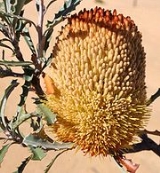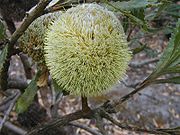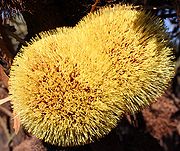
Banksia ser. Ochraceae
Encyclopedia
Banksia ser. Ochraceae is a valid botanic name for a taxonomic
series
within the plant
genus
Banksia
. It was published by Kevin Thiele
in 1996, but discarded by Alex George
in 1999.
of Banksia by Thiele and Pauline Ladiges yielded a phylogeny somewhat at odds with the arrangement of
Alex George
. They found George's B. ser. Cyrtostylis
to be "widely polyphyletic", with six of its fourteen taxa occurring singly in locations throughout the cladogram
; these were transferred to other series or left incertae sedis
. The remaining eight taxa formed a clade
, which further resolved into two subclades:
ochraceae ("ochre-coloured"), in reference to the colour of the inflorescence
s of most species in that series. It was formally defined as containing those species with "linear-terete pollen-presenters that are scarcely distinct from the style, very small, narrowly flabellate-tridentate early seedling leaves, and often browning-orange inflorescences". B. benthamiana
(Bentham's Banksia) was designated the type species.
The placement and circumscription of B. ser. Ochraceae in Thiele and Ladiges' arrangement of Banksia
may be summarised as follows:


Thiele and Ladiges' arrangement remained current only until 1999, when it was overturned by George.
has been publishing results of ongoing cladistic analyses of DNA sequence
data for the subtribe Banksiinae. His analyses suggest a phylogeny that is rather different to previous taxonomic arrangements. With respect to B. ser. Ochraceae, Mast's results differ somewhat from the arrangement of Thiele and Ladiges. B. benthamiana and B. audax appear to be closely related, but B. laevigata forms only one of three polytomous sister clades to it, and the clade corresponding to Thiele and Ladiges' B. ser. Cyrtostylis is not particularly close.
Early in 2007 Mast and Thiele initiated a rearrangement of Banksia by transferring Dryandra into it, and publishing B. subg. Spathulatae
for the species having spoon-shaped cotyledon
s; in this way they also redefined the autonym
B. subg. Banksia
. All members of B. ser. Ochraceae fall within Mast and Thiele's B. subg. Banksia, but nothing further has been published. Mast and Thiele have foreshadowed publishing a full arrangement once DNA sampling of Dryandra is complete.
Taxonomy
Taxonomy is the science of identifying and naming species, and arranging them into a classification. The field of taxonomy, sometimes referred to as "biological taxonomy", revolves around the description and use of taxonomic units, known as taxa...
series
Series (botany)
Series is a low-level taxonomic rank below that of section but above that of species.In botany, a series is a subdivision of a genus...
within the plant
Plant
Plants are living organisms belonging to the kingdom Plantae. Precise definitions of the kingdom vary, but as the term is used here, plants include familiar organisms such as trees, flowers, herbs, bushes, grasses, vines, ferns, mosses, and green algae. The group is also called green plants or...
genus
Genus
In biology, a genus is a low-level taxonomic rank used in the biological classification of living and fossil organisms, which is an example of definition by genus and differentia...
Banksia
Banksia
Banksia is a genus of around 170 species in the plant family Proteaceae. These Australian wildflowers and popular garden plants are easily recognised by their characteristic flower spikes and fruiting "cones" and heads. When it comes to size, banksias range from prostrate woody shrubs to trees up...
. It was published by Kevin Thiele
Kevin Thiele
Kevin R. Thiele is curator of the Western Australian Herbarium. His research interests include the systematics of the plant families Proteaceae, Rhamnaceae and Violaceae, and the conservation ecology of grassy woodland ecosystems...
in 1996, but discarded by Alex George
Alex George
Alexander Segger George is a Western Australian botanist. He is the authority on the plant genera Banksia and Dryandra...
in 1999.
Cladistics
The name came about after a cladistic analysisCladistics
Cladistics is a method of classifying species of organisms into groups called clades, which consist of an ancestor organism and all its descendants . For example, birds, dinosaurs, crocodiles, and all descendants of their most recent common ancestor form a clade...
of Banksia by Thiele and Pauline Ladiges yielded a phylogeny somewhat at odds with the arrangement of
George's taxonomic arrangement of Banksia
Alex George's taxonomic arrangement of Banksia was the first modern-day arrangement for that genus. First published in 1981 in the classic monograph The genus Banksia L.f. , it superseded the arrangement of George Bentham, which had stood for over a hundred years. It was overturned in 1996 by Kevin...
Alex George
Alex George
Alexander Segger George is a Western Australian botanist. He is the authority on the plant genera Banksia and Dryandra...
. They found George's B. ser. Cyrtostylis
Banksia ser. Cyrtostylis
Banksia ser. Cyrtostylis is a valid botanic name for a taxonomic series within the plant genus Banksia. First published at sectional rank by George Bentham in 1870, it was demoted to a series by Alex George in 1981. The name has had three circumscriptions.-According to Bentham:Bentham published B....
to be "widely polyphyletic", with six of its fourteen taxa occurring singly in locations throughout the cladogram
Cladogram
A cladogram is a diagram used in cladistics which shows ancestral relations between organisms, to represent the evolutionary tree of life. Although traditionally such cladograms were generated largely on the basis of morphological characters, DNA and RNA sequencing data and computational...
; these were transferred to other series or left incertae sedis
Incertae sedis
, is a term used to define a taxonomic group where its broader relationships are unknown or undefined. Uncertainty at specific taxonomic levels is attributed by , , and similar terms.-Examples:*The fossil plant Paradinandra suecica could not be assigned to any...
. The remaining eight taxa formed a clade
Clade
A clade is a group consisting of a species and all its descendants. In the terms of biological systematics, a clade is a single "branch" on the "tree of life". The idea that such a "natural group" of organisms should be grouped together and given a taxonomic name is central to biological...
, which further resolved into two subclades:
Taxonomy
Thiele and Ladiges preferred to give series rank to the subclades, rather than the entire clade, so they transferred the taxa of the second clade into a new series, retaining only the taxa of the first clade in B. ser. Cyrtostylis. The new series was given the name B. ser. Ochraceae, from the LatinLatin
Latin is an Italic language originally spoken in Latium and Ancient Rome. It, along with most European languages, is a descendant of the ancient Proto-Indo-European language. Although it is considered a dead language, a number of scholars and members of the Christian clergy speak it fluently, and...
ochraceae ("ochre-coloured"), in reference to the colour of the inflorescence
Inflorescence
An inflorescence is a group or cluster of flowers arranged on a stem that is composed of a main branch or a complicated arrangement of branches. Strictly, it is the part of the shoot of seed plants where flowers are formed and which is accordingly modified...
s of most species in that series. It was formally defined as containing those species with "linear-terete pollen-presenters that are scarcely distinct from the style, very small, narrowly flabellate-tridentate early seedling leaves, and often browning-orange inflorescences". B. benthamiana
Banksia benthamiana
Bentham's Banksia is a species of shrub or tree in the plant genus Banksia. It occurs in scattered populations in the Wheatbelt region of Western Australia, one near Mullewa and the other near Dalwallinu.-Description:...
(Bentham's Banksia) was designated the type species.
The placement and circumscription of B. ser. Ochraceae in Thiele and Ladiges' arrangement of Banksia
Thiele and Ladiges' taxonomic arrangement of Banksia
Kevin Thiele and Pauline Ladiges' taxonomic arrangement of Banksia, published in 1996, was a novel taxonomic arrangement that was intended to align the taxonomy of Banksia more closely with the phylogeny that they had inferred from their cladistic analysis of the genus...
may be summarised as follows:


- Banksia
- B. subg. IsostylisBanksia subg. IsostylisBanksia subg. Isostylis is a subgenus of Banksia. It contains three closely related species, all of which occur only in Southwest Western Australia. Members of subgenus Isostylis have dome-shaped flower heads that are superficially similar to those of B. ser...
(3 species) - B. elegansBanksia elegansThe Elegant Banksia is a species of shrub or small tree in the plant genus Banksia. It occurs only over a 65 square kilometre area north and west of Eneabba, Western Australia.-Ecology:...
(incertae sedis) - B. subg. BanksiaBanksia subg. BanksiaBanksia subg. Banksia is a valid botanic name for a subgenus of Banksia. As an autonym, it necessarily contains the type species of Banksia, B. serrata . Within this constraint, however, there have been various circumscriptions.-Banksia verae:B. subg...
- B. ser. TetragonaeBanksia ser. TetragonaeBanksia ser. Tetragonae is a taxonomic series in the genus Banksia. It consists of three closely related species of erect shrub with pendulous inflorescences in section Banksia. These are B. lemanniana , B. caleyi and B. aculeata ....
(4 species) - B. ser. Lindleyanae (1 species)
- B. ser. BanksiaBanksia ser. BanksiaBanksia ser. Banksia is avalid botanic name for a series of Banksia. As an autonym, it necessarily contains the type species of Banksia, B. serrata . Within this constraint, however, there have been various circumscriptions.-According to Bentham:Banksia ser. Banksia originated in 1870 as...
(2 subseries, 12 species) - B. baueriBanksia baueriThe Woolly Banksia is a species of shrub in the plant genus Banksia. It occurs in southwest Western Australia north and east of Albany. It has a distinctively large and hairy looking inflorescence which can be 300 mm or more long and up to 200 mm in diameter.It is placed alone in series...
(incertae sedis) - B. lullfitziiBanksia lullfitziiBanksia lullfitzii is a species of shrub in the plant genus Banksia. A many-branched, spreading bush with golden-orange flowers, it occurs in scattered populations over a large area of the eastern goldfields of Western Australia...
(incertae sedis) - B. attenuataBanksia attenuataBanksia attenuata, commonly known as the candlestick banksia or slender banksia, is a species of plant in the proteaceae family. Commonly a tree, it reaches 10 m high, but is often a shrub in dryer areas 0.4 to 2 m high...
(incertae sedis) - B. ashbyiBanksia ashbyiThe Ashby's Banksia is a species of shrub in the plant genus Banksia. It occurs in heath and spinifex country along the coast of Western Australia between Geraldton and Exmouth.-Description:...
(incertae sedis) - B. coccineaBanksia coccineaBanksia coccinea, commonly known as the Scarlet Banksia, Waratah Banksia or Albany Banksia, is an erect shrub or small tree in the plant genus Banksia...
(incertae sedis) - B. ser. ProstrataeBanksia ser. ProstrataeBanksia ser. Prostratae is a taxonomic series in the genus Banksia. It consists of six closely related species in section Banksia, all endemic to Western Australia, with a prostrate habit.Banksia ser...
(8 species) - B. ser. CyrtostylisBanksia ser. CyrtostylisBanksia ser. Cyrtostylis is a valid botanic name for a taxonomic series within the plant genus Banksia. First published at sectional rank by George Bentham in 1870, it was demoted to a series by Alex George in 1981. The name has had three circumscriptions.-According to Bentham:Bentham published B....
(4 species) - B. ser. Ochraceae
- B. benthamianaBanksia benthamianaBentham's Banksia is a species of shrub or tree in the plant genus Banksia. It occurs in scattered populations in the Wheatbelt region of Western Australia, one near Mullewa and the other near Dalwallinu.-Description:...
- B. audaxBanksia audaxBanksia audax is a species of shrub in the plant genus Banksia. It occurs over a large area in the central south of Western Australia.-Description:...
- B. laevigataBanksia laevigataBanksia laevigata is a species of shrub in the plant genus Banksia. It occurs in Western Australia's semi-arid shrubland from Southern Cross south to the Fitzgerald River National Park. It is composed of two closely related subspecies, B. laevigata subsp. laevigata and B. laevigata...
- B. laevigata subsp. laevigataBanksia laevigata subsp. laevigataThe Tennis Ball Banksia is a subspecies of small woody shrub in the plant genus Banksia. It occurs in Western Australia's semi-arid shrubland. It and the closely related B. laevigata subsp...
- B. laevigata subsp. fuscoluteaBanksia laevigata subsp. fuscoluteaBanksia laevigata subsp. fuscolutea is a subspecies of Banksia laevigata. It is native to the Southwest Botanical Province of Western Australia....
- B. laevigata subsp. laevigata
- B. benthamiana
- B. ser. GrandesBanksia ser. GrandesBanksia ser. Grandes is a taxonomic series in the genus Banksia. It consists of two closely related species in section Banksia, both endemic to Western Australia. These are B. grandis and B. solandri ....
(2 species) - B. ser. SalicinaeBanksia ser. SalicinaeBanksia ser. Salicinae is a valid botanic name for a series of Banksia. First published by Carl Meissner in 1856, the name has had three circumscriptions.-According to Meissner:...
(2 series, 11 species, 4 subspecies) - B. ser. SpicigeraeBanksia ser. SpicigeraeBanksia ser. Spicigerae is a taxonomic series in the genus Banksia. It consists of the seven species in section Oncostylis that have cylindrical inflorescences. These range in form from small shrubs to tall trees. The leaves grow in either an alternate or whorled pattern, with various shape forms...
(3 series, 7 species, 6 varieties) - B. ser. QuercinaeBanksia ser. QuercinaeBanksia ser. Quercinae is avalid botanic name for a series of Banksia. First published by Carl Meissner in 1856, the name has had three circumscriptions.-According to Meissner:...
(2 species) - B. ser. DryandroideaeBanksia ser. DryandroideaeBanksia ser. Dryandroideae is a valid botanic name for a taxonomic series in the plant genus Banksia. First published by Carl Meissner in 1856, the name has had two circumscriptions. As presently circumscribed it is monotypic, containing only B. dryandroides.-According to Meissner:B. ser...
(1 species) - B. ser. AbietinaeBanksia ser. AbietinaeBanksia ser. Abietinae is avalid botanic name for a series of Banksia. First published by Carl Meissner in 1856, the name has had three circumscriptions.-According to Meissner:...
(4 subseries, 15 species, 8 varieties)
- B. ser. Tetragonae
- B. subg. Isostylis
Thiele and Ladiges' arrangement remained current only until 1999, when it was overturned by George.
Recent developments
Since 1998, Austin MastAustin Mast
Austin R. Mast is a research botanist. Born in 1972, he obtained a Ph.D. from the University of Wisconsin–Madison in 2000. He is currently an associate professor within the Department of Biological Science at Florida State University , and has been director of FSU's since August 2003.One of his...
has been publishing results of ongoing cladistic analyses of DNA sequence
DNA sequence
The sequence or primary structure of a nucleic acid is the composition of atoms that make up the nucleic acid and the chemical bonds that bond those atoms. Because nucleic acids, such as DNA and RNA, are unbranched polymers, this specification is equivalent to specifying the sequence of...
data for the subtribe Banksiinae. His analyses suggest a phylogeny that is rather different to previous taxonomic arrangements. With respect to B. ser. Ochraceae, Mast's results differ somewhat from the arrangement of Thiele and Ladiges. B. benthamiana and B. audax appear to be closely related, but B. laevigata forms only one of three polytomous sister clades to it, and the clade corresponding to Thiele and Ladiges' B. ser. Cyrtostylis is not particularly close.
Early in 2007 Mast and Thiele initiated a rearrangement of Banksia by transferring Dryandra into it, and publishing B. subg. Spathulatae
Banksia subg. Spathulatae
Banksia subg. Spathulatae is a valid botanic name for a subgenus of Banksia. It was published in 2007 by Austin Mast and Kevin Thiele, and defined as containing all those Banksia species having spathulate cotyledons...
for the species having spoon-shaped cotyledon
Cotyledon
A cotyledon , is a significant part of the embryo within the seed of a plant. Upon germination, the cotyledon may become the embryonic first leaves of a seedling. The number of cotyledons present is one characteristic used by botanists to classify the flowering plants...
s; in this way they also redefined the autonym
Autonym (botany)
In botanical nomenclature, autonyms are automatically created names, as regulated by the International Code of Botanical Nomenclature . Autonyms are cited without an author. Relevant provisions are in articles 6.8, 22.1-3 and 26.1-3....
B. subg. Banksia
Banksia subg. Banksia
Banksia subg. Banksia is a valid botanic name for a subgenus of Banksia. As an autonym, it necessarily contains the type species of Banksia, B. serrata . Within this constraint, however, there have been various circumscriptions.-Banksia verae:B. subg...
. All members of B. ser. Ochraceae fall within Mast and Thiele's B. subg. Banksia, but nothing further has been published. Mast and Thiele have foreshadowed publishing a full arrangement once DNA sampling of Dryandra is complete.

